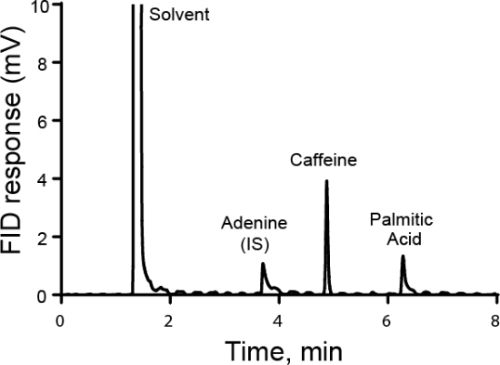内部标准
Overview
资料来源: 实验室的博士 B.吉尔 Venton-弗吉尼亚大学
许多化学分析的目标是物质的定量分析,样品中的量物质的确定在哪里。为了准确地计算未知样品的浓度,小心样品制备是关键。每次处理或转移样品时,样品的一些可能会丢失。将样品损失降至最低,为战略。也有应对样品损失和仍然进行准确的测量浓度的战略。
为了尽量减少样品损失,理想是尽量的样品处理和转移步骤数。例如,直接进入解决方案将在烧瓶集结固体样品降低了转移步骤。如果有必要从一瓶转移到另一个,并被稀释,然后三清洗玻璃器皿有助于确保所有的样品转移。其他战略是更具体的样品。例如,一次性的聚丙烯管亦可能更好地处理样品吸附到玻璃,比如蛋白质。管不是样本的亲水,所以如果可以吸取水中极少量,它是样本的最好已经掺过水的管,所以可以直接进入溶剂吸取样品。它可能是更好地集中注意力,而不是完全干燥样品,从 insolubilities 再水化后的损失。
样品损失的另一个来源是通过不完整示例操作。例如,如果使用衍生过程和衍生化不完整,样品的全部数额是没有观察到。像这样的错误是系统误差,并通过纠正的问题,例如更改衍生过程就可以迎刃而解。在测量系统误差的另一个原因是基体效应。这些示例可以减少这种影响可以干涉测量的某些物质和表演校准在相同的矩阵。
定量分析通常进行使用外部或内部的标准。为外部标准,校准曲线是通过测量不同已知的浓度的感兴趣。然后,从标准分别运行示例。内部标准,该标准已经作为被测物的兴趣,使测量同时采取相同的样本。通常情况下,一个不同的物种添加内部标准和比例的响应呼吁,内部的标准和计算分析物。这个想法是反应,称为响应因子,比他们的浓度成正比。方法必须能够区分的利益被分析物和内部标准,任何样品损失发生后添加的内部标准应该是类似的两种物质,而因此响应的比率保持不变。使用内部标准的一个特殊情况是标准的附加,哪里添加到解决方案中越来越多的被分析物和原始的分析物量反算的方法。内部标准可用于色谱法、 电化学和光谱。
Procedure
1.适当的样品处理: 制作解决方案
- 带上干净的烧杯和大众正确的样品量到它。记录实际的大规模使用。在此示例中,腺嘌呤的解决方案是在容量瓶作为一种内部的标准用于下一个分析。腺嘌呤的质量是 100 毫克。做不直接大规模到容量瓶,因为它有一个长脖子和腺嘌呤不能轻松地添加或删除。
- 添加约 25 毫升的溶剂 (在这种情况下二甲基亚砜 (DMSO)) 的烧杯和让它搅拌溶解。在此示例中,最后的解决办法是在 50 毫升的容量瓶,所以只添加约 25 毫升,所以可以冲洗烧杯和解决方案到最后卷组成。
- 一旦溶解固体,溶液倒入容量瓶。
- 冲洗烧杯和少量的溶剂,约 10 毫升,搅拌棒,倒入容量瓶的冲洗。重复两次以上。这有助于确保适当的解决方案转移。
2.内部标准校准曲线的制备
- 气相色谱法分析准备所需的标准样品。在此示例中,从咖啡用乙腈提取咖啡因和腺嘌呤然后作为一种内部的标准用于测量。
- 对于咖啡因的样本,称出 1 毫克/毫升样品所需的样品的取样量。如果使用 10 毫升的容量瓶
Application and Summary
Tags
跳至...
此集合中的视频:

Now Playing
内部标准
Analytical Chemistry
204.9K Views

分析制备的样品制备
Analytical Chemistry
84.8K Views

标准加入的方法
Analytical Chemistry
320.2K Views

校准曲线
Analytical Chemistry
797.2K Views

(紫外-可见) 的紫外-可见光谱法
Analytical Chemistry
623.9K Views

拉曼光谱化学分析
Analytical Chemistry
51.2K Views

X 射线荧光光谱 (XRF)
Analytical Chemistry
25.4K Views

气相色谱 (GC) 与火焰电离检测
Analytical Chemistry
282.2K Views

高性能液相色谱法 (HPLC)
Analytical Chemistry
384.9K Views

离子交换色谱法
Analytical Chemistry
264.6K Views

毛细管电泳 (CE)
Analytical Chemistry
94.0K Views

质谱分析法导论
Analytical Chemistry
112.3K Views

扫描电子显微镜 (SEM)
Analytical Chemistry
87.3K Views

负载型催化剂,用恒电位仪/结合电化学测量
Analytical Chemistry
51.4K Views

循环伏安法 (CV)
Analytical Chemistry
125.4K Views
版权所属 © 2025 MyJoVE 公司版权所有,本公司不涉及任何医疗业务和医疗服务。

